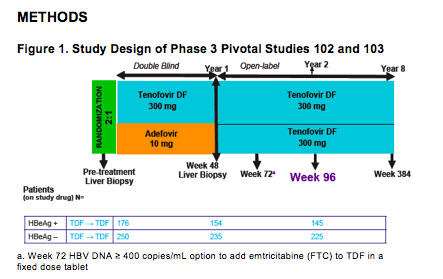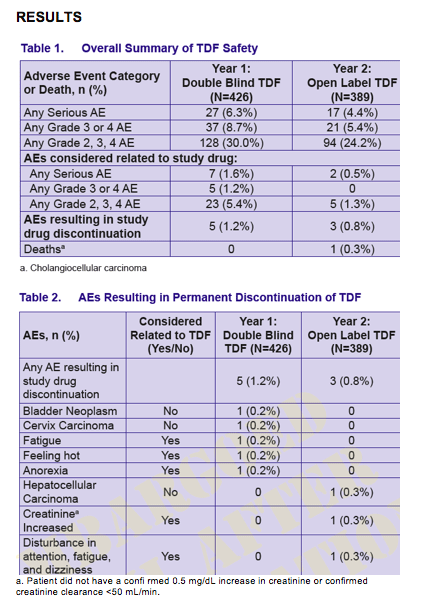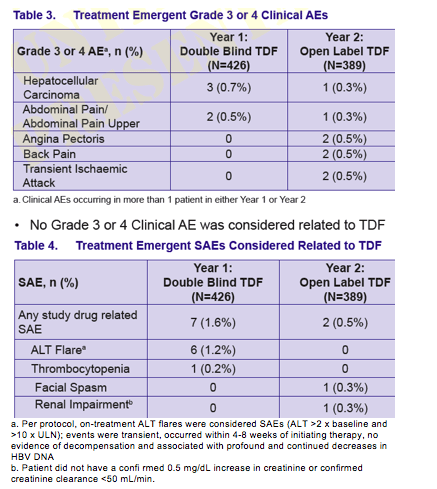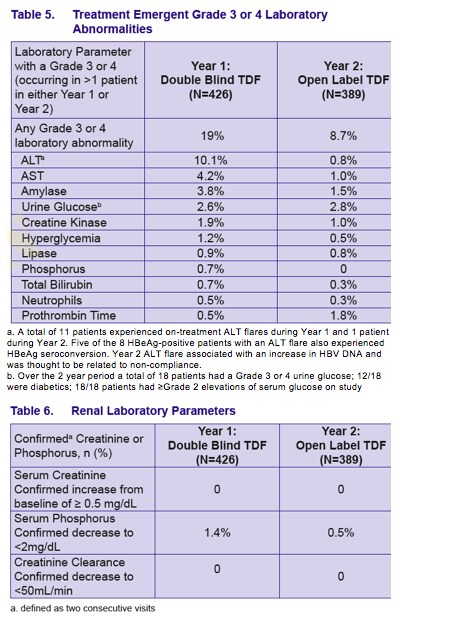 |
 |
 |
| |
Safety and Tolerability of 96 Weeks of Tenofovir Disoproxil Fumarate (TDF) Treatment in HBeAg Negative and Positive Patients Infected with Chronic Hepatitis B (CHB)
|
| |
| |
EASL
Reported by Jules Levin
P Marcellin1, E J Heathcote2, I Jacobson3, P Mathurin4, E Gane5, P Buggisch6, P Husa7 Z Krastev8, J Sorbel9, J Anderson9, E Mondou9 and F Rousseau9
1University of Paris, Clichy France; 2University of Toronto, Toronto ONT, Canada; 3Weill Medical College of Cornell University, New York, NY; 4Service d'Hepato-Gastroenterologie, Hopital Claude Huriez, CHRU
Lille, Lille, France; 5Middlemore Hospital, Auckland New Zealand; 6Medizinische Universitatsklinik Eppendorf, Hamburg Germany; 7University Hospital,BRNO, Czech Republic; 8University Hospital "St Ivan
Rilsky", Sofia, Bulgaria; 9Gilead Sciences, Durham NC
AUTHOR CONCLUSIONS
The safety and tolerability profile of tenofovir DF was good and did not show any new or unexpected adverse events in the HBV-infected population
The renal safety of tenofovir DF was good and confirms the profile established in patients with HIV-infection
The virologic safety profile of tenofovir DF remains excellent with 0% resistance at 2 years
INTRODUCTION
· Tenofovir DF (TDF) is a nucleotide analog and obligate chain terminator
· Approved for HIV-1 in 2001: ~ 2 million patient-years of experience
· Approved for chronic hepatitis B (CHB) in 2008
· TDF was well tolerated through 48 weeks of treatment in the
Phase 3 CHB studies 102 and 103
· Week 48 Phase 3 data1 showed that TDF had superior antiviral efficacy to adefovir dipivoxil (ADV) in the pivotal studies 102 and 103:
- 93% vs 63% (HBeAg-negative) and 76% vs 13% (HBeAg-positive) patients achieved HBV DNA <400 copies/mL (69 IU/mL) (ITT)
· TDF continues to demonstrate durable, potent antiviral effi cacy at Week 962,3:
- 91% of HBeAg-negative patients and 78% of HBeAg positive patients had HBV DNA <400 copies/mL (ITT)
OBJECTIVE
To evaluate the overall safety of 96 weeks (2 years) of treatment with TDF in both HBeAg-positive and HBeAg-negative patients enrolled in the phase 3, pivotal studies 102 and 103
SAFETY ENDPOINTS
Safety and tolerability
· Deaths
· Serious Adverse Events (SAEs)
· Grade 3 or 4 Adverse Events (AEs)
· Related SAEs and Grade 3 or 4 AEs
· (AEs) leading to study drug discontinuation
· Grade 3 or 4 laboratory abnormalities
· Renal tolerability (confi rmed increase ≥ 0.5 mg/dL in creatinine; creatinine clearance <50 ml/min; phosphorus < 2mg/dL)
· Resistance Mutations

Safety monitoring:
· Patient visits every 4 to 8 weeks
· Monitored for SAEs and AEs
· Standard laboratory tests, e.g., liver function tests, serum chemistries and hematology
· Resistance



None of the patients with a confirmed decrease in phosphorus
had a concurrent and/or clinically significant increase in
creatinine or decrease in creatinine clearance.
Virologic Safety
No HBV pol/RT amino acid substitutions associated with TDF resistance were detected through 96 weeks of TDF monotherapy in HBeAg-negative and HBeAg-positive patients
References
1. Marcellin P, Heathcote J, Buti M et al Tenofovir Disoproxil Fumarate versus Adefovir Dipivoxil for Chronic Hepatitis B. NEJM 2008, Vol 359, pg 2442-2455.
2. Marcellin P, Buti M, Krastev Z et al . Two Year Tenofovir Disoproxil Fumarate (TDF) Treatment and Adefovir Dipivoxil (ADV) Switch Data in HBeAg-Negative Patients with Chronic Hepatitis B (Study 102) presented at AASLD 2008 (#146).
3. Heathcote J, Gane E, DeMan R et al. Two Year Tenofovir Disoproxil Fumarate (TDF) Treatment and Adefovir Dipivoxil (ADV) Switch Data in HBeAg-Positve Patients with Chronic Hepatitis B (Study 103) presented at AASLD 2008 (#158).
|
| |
|
 |
 |
|
|